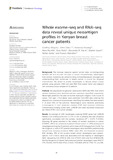Whole exome-seq and RNA-seq data reveal unique neoantigen profiles in Kenyan breast cancer patients

View/
Date
2024-12-11Author
Wagutu, Godfrey
Gitau, John
Mwangi, Kennedy
Murithi, Mary
Melly, Elias
Harris, Alexandra R.
Sayed, Shahin
Ambs, Stefan
Makokha, Francis
Metadata
Show full item recordAbstract
Background: The immune response against tumors relies on distinguishing
between self and non-self, the basis of cancer immunotherapy. Neoantigens
from somatic mutations are central to many immunotherapeutic strategies and
understanding their landscape in breast cancer is crucial for targeted
interventions. We aimed to profile neoantigens in Kenyan breast cancer
patients using genomic DNA and total RNA from paired tumor and adjacent
non-cancerous tissue samples of 23 patients.
Methods: We sequenced the genome-wide exome (WES) and RNA, from which
somatic mutations were identified and their expression quantified, respectively.
Neoantigen prediction focused on human leukocyte antigens (HLA) crucial to
cancer, HLA type I. HLA alleles were predicted from WES data covering the
adjacent non-cancerous tissue samples, identifying four alleles that were present
in at least 50% of the patients. Neoantigens were deemed potentially
immunogenic if their predicted median IC50 (half-maximal inhibitory
concentration) binding scores were ≤500nM and were expressed [transcripts
per million (TPM) >1] in tumor samples.
Results: An average of 1465 neoantigens covering 10260 genes had ≤500nM
median IC50 binding score and >1 TPM in the 23 patients and their presence
significantly correlated with the somatic mutations (R2 = 0.570, P=0.001).
Assessing 58 genes reported in the catalog of somatic mutations in cancer
(COSMIC, v99) to be commonly mutated in breast cancer, 44 (76%) produced >2
neoantigens among the 23 patients, with a mean of 10.5 ranging from 2 to 93. For
the 44 genes, a total of 477 putative neoantigens were identified, predominantly
derived from missense mutations (88%), indels (6%), and frameshift mutations
(6%). Notably, 78% of the putative breast cancer neoantigens were patientspecific.
HLA-C*06:01 allele was associated with the majority of neoantigens
(194), followed by HLA-A*30:01 (131), HLA-A*02:01 (103), and HLA-B*58:01 (49).
Among the genes of interest that produced putative neoantigens were MUC17,
TTN, MUC16, AKAP9, NEB, RP1L1, CDH23, PCDHB10, BRCA2, TP53, TG, and RB1. Conclusions: The unique neoantigen profiles in our patient group highlight the
potential of immunotherapy in personalized breast cancer treatment as well as
potential biomarkers for prognosis. The unique mutations producing these
neoantigens, compared to other populations, provide an opportunity for
validation in a much larger sample cohort.
Collections
- Staff Collection [24]
